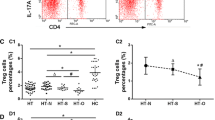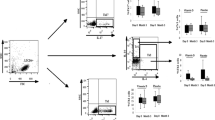Abstract
TCR γδ+ Τ cells are important in the pathogenesis of inflammatory and autoimmune conditions. This study investigated the effect of γδ T cells on autoantibody production in patients with Hashimoto’s thyroiditis (HT). A total of 148 subjects were enrolled, including 99 patients with HT, 5 with simple goiters, and 44 healthy controls. Peripheral blood and thyroid mononuclear cells were subjected to flow cytometric analysis. Thyroid tissues underwent immunofluorescent staining and immunohistochemistry for γδ T cells and anti-thyroid antibody detection. Antibody production was measured by ELISA and automated chemiluminescent immunoassays. And activation and apoptosis of peripheral blood γδT cells and B cells were measured by flow cytometric analysis. The percentage of γδ T cells were greater in thyroid tissue from HT patients than that of goiter patients (n = 5, 5.33 ± 1.20 vs. 2.07 ± 0.44 %; P < 0.05), with the Vδ1+ γδ T cell subset especially dominant. Frequencies of CD69 (8.42 ± 1.08 vs. 1.60 ± 0.38 %, P < 0.001), HLA-DR (58.12 ± 6.36 vs. 37.82 ± 3.70 %, P < 0.05), CD40L (1.58 ± 0.35 vs. 0.15 ± 0.05 %, P < 0.01), and ICOS (2.78 ± 0.66 vs. 0.28 ± 0.13 %, P < 0.01) expressed on γδ T cells from HT patients (n = 19) were significantly increased compared with those of healthy controls (n = 15). More importantly, γδ T cells from HT patients enhanced B cells for antibody production, and all-trans retinoic acid (ATRA) treatment inhibited the effect by inducing apoptosis of γδ Τ cells. γδ Τ cells appear to play an important role in the pathogenesis of HT, and ATRA might be an effective regulator for HT patients.




Similar content being viewed by others
References
E.N. Pearce, A.P. Farwell, L.E. Braverman, Thyroiditis. N. Engl. J. Med. 348(26), 2646–2655 (2003)
H.E. Takami, R. Miyabe, K. Kameyama, Hashimoto’s thyroiditis. World J. Surg. 32(5), 688–692 (2008)
A.P. Weetman, Autoimmune thyroid disease. Autoimmunity 37(4), 337–340 (2004)
C. Zhu, J. Ma, Y. Liu, J. Tong, J. Tian, J. Chen, X. Tang, H. Xu, L. Lu, S. Wang, Increased frequency of follicular helper T cells in patients with autoimmune thyroid disease. J. Clin. Endocrinol. Metab. 97(3), 943–950 (2012)
P. Caturegli, A. De Remigis, K. Chuang, M. Dembele, A. Iwama, S. Iwama, Hashimoto’s thyroiditis: celebrating the centennial through the lens of the Johns Hopkins hospital surgical pathology records. Thyroid 23(2), 142–150 (2013)
J.C. Ribot, A. Debarros, B. Silva-Santos, Searching for “signal 2”: costimulation requirements of gammadelta T cells. Cell. Mol. Life Sci. 68(14), 2345–2355 (2011)
A.C. Hayday, [gamma][delta] cells: a right time and a right place for a conserved third way of protection. Annu. Rev. Immunol. 18, 975–1026 (2000)
W. Haas, P. Pereira, S. Tonegawa, Gamma/delta cells. Annu. Rev. Immunol. 11, 637–685 (1993)
C. Mao, X. Mou, Y. Zhou, G. Yuan, C. Xu, H. Liu, T. Zheng, J. Tong, S. Wang, D. Chen, Tumor-activated TCR gammadelta (+) T cells from gastric cancer patients induce the antitumor immune response of TCRalphabeta (+) T cells via their antigen-presenting cell-like effects. J. Immunol. Res. 2014, 593562 (2014)
D. Su, M. Shen, X. Li, L. Sun, Roles of gammadelta T cells in the pathogenesis of autoimmune diseases. Clin. Dev. Immunol. 2013, 985753 (2013)
S. Rajagopalan, T. Zordan, G.C. Tsokos, S.K. Datta, Pathogenic anti-DNA autoantibody-inducing T helper cell lines from patients with active lupus nephritis: isolation of CD4-8-T helper cell lines that express the gamma delta T-cell antigen receptor. Proc. Natl. Acad. Sci. USA 87(18), 7020–7024 (1990)
A.A. Horner, H. Jabara, N. Ramesh, R.S. Geha, gamma/delta T lymphocytes express CD40 ligand and induce isotype switching in B lymphocytes. J. Exp. Med. 181(3), 1239–1244 (1995)
N. Caccamo, L. Battistini, M. Bonneville, F. Poccia, J.J. Fournie, S. Meraviglia, G. Borsellino, R.A. Kroczek, C. La Mendola, E. Scotet et al., CXCR5 identifies a subset of Vgamma9Vdelta2 T cells which secrete IL-4 and IL-10 and help B cells for antibody production. J. Immunol. 177(8), 5290–5295 (2006)
M. Mark, N.B. Ghyselinck, P. Chambon, Retinoic acid signalling in the development of branchial arches. Curr. Opin. Genet. Dev. 14(5), 591–598 (2004)
D. Liang, A. Zuo, H. Shao, W.K. Born, R.L. O’Brien, H.J. Kaplan, D. Sun, Retinoic acid inhibits CD25+ dendritic cell expansion and gammadelta T-cell activation in experimental autoimmune uveitis. Invest. Ophthalmol. Vis. Sci. 54(5), 3493–3503 (2013)
L.A. Mielke, S.A. Jones, M. Raverdeau, R. Higgs, A. Stefanska, J.R. Groom, A. Misiak, L.S. Dungan, C.E. Sutton, G. Streubel et al., Retinoic acid expression associates with enhanced IL-22 production by gammadelta T cells and innate lymphoid cells and attenuation of intestinal inflammation. J. Exp. Med. 210(6), 1117–1124 (2013)
A. Yokota, H. Takeuchi, N. Maeda, Y. Ohoka, C. Kato, S.Y. Song, M. Iwata, GM-CSF and IL-4 synergistically trigger dendritic cells to acquire retinoic acid-producing capacity. Int. Immunol. 21(4), 361–377 (2009)
B. Hoechst, J. Gamrekelashvili, M.P. Manns, T.F. Greten, F. Korangy, Plasticity of human Th17 cells and iTregs is orchestrated by different subsets of myeloid cells. Blood 117(24), 6532–6541 (2011)
L. Saurer, K.C. McCullough, A. Summerfield, In vitro induction of mucosa-type dendritic cells by all-trans retinoic acid. J. Immunol. 179(6), 3504–3514 (2007)
http://www.japanthyroid.jp/en/guidelines.html#chr. Diagnostic guidelines made by The Japan Thyroid Association
M.H. Rho, D.W. Kim, H.P. Hong, Y.M. Park, M.J. Kwon, S.J. Jung, Y.W. Kim, T. Kang, Diagnostic value of antithyroid peroxidase antibody for incidental autoimmune thyroiditis based on histopathologic results. Endocrine 42, 647–652 (2012)
F. Cicone, A. Papa, C. Lauri, A. Tofani, C. Virili, M. Centanni, F. Scopinaro, B. Annibale, Thyro-gastric autoimmunity in patients with differentiated thyroid cancer: a prospective study. Endocrine 49(1), 163–169 (2015)
F. Paolieri, C. Pronzato, M. Battifora, N. Fiorino, G.W. Canonica, M. Bagnasco, Infiltrating gamma/delta T-cell receptor-positive lymphocytes in Hashimoto’s thyroiditis, Graves’ disease and papillary thyroid cancer. J. Endocrinol. Invest. 18(4), 295–298 (1995)
D. Liang, A. Zuo, H. Shao, W.K. Born, R.L. O’Brien, H.J. Kaplan, D. Sun, Retinoic acid inhibits CD25+ dendritic cell expansion and gammadelta T-cell activation in experimental autoimmune uveitis. Invest. Ophthalmol. Vis. Sci. 54(5), 3493–3503 (2013)
N. Figueroa-Vega, M. Alfonso-Perez, I. Benedicto, F. Sanchez-Madrid, R. Gonzalez-Amaro, M. Marazuela, Increased circulating pro-inflammatory cytokines and Th17 lymphocytes in Hashimoto’s thyroiditis. J. Clin. Endocrinol. Metab. 95(2), 953–962 (2010)
M. Marazuela, M.A. Garcia-Lopez, N. Figueroa-Vega, H. de la Fuente, B. Alvarado-Sanchez, A. Monsivais-Urenda, F. Sanchez-Madrid, R. Gonzalez-Amaro, Regulatory T cells in human autoimmune thyroid disease. J. Clin. Endocrinol. Metab. 91(9), 3639–3646 (2006)
I.S. Grewal, R.A. Flavell, CD40 and CD154 in cell-mediated immunity. Annu. Rev. Immunol. 16, 111–135 (1998)
A. Hutloff, A.M. Dittrich, K.C. Beier, B. Eljaschewitsch, R. Kraft, I. Anagnostopoulos, R.A. Kroczek, ICOS is an inducible T-cell co-stimulator structurally and functionally related to CD28. Nature 397(6716), 263–266 (1999)
P. Chambon, A decade of molecular biology of retinoic acid receptors. FASEB J. 10(9), 940–954 (1996)
X. Du, K. Tabeta, N. Mann, K. Crozat, S. Mudd, B. Beutler, An essential role for Rxr alpha in the development of Th2 responses. Eur. J. Immunol. 35(12), 3414–3423 (2005)
T.T. Schug, D.C. Berry, N.S. Shaw, S.N. Travis, N. Noy, Opposing effects of retinoic acid on cell growth result from alternate activation of two different nuclear receptors. Cell 129(4), 723–733 (2007)
M.A. Kane, A.E. Folias, C. Wang, J.L. Napoli, Ethanol elevates physiological all-trans-retinoic acid levels in select loci through altering retinoid metabolism in multiple loci: a potential mechanism of ethanol toxicity. FASEB J. 24(3), 823–832 (2010)
S.M. Smith, C.E. Hayes, Contrasting impairments in IgM and IgG responses of vitamin A-deficient mice. Proc. Natl. Acad. Sci. USA 84(16), 5878–5882 (1987)
K. Morikawa, M. Nonaka, All-trans-retinoic acid accelerates the differentiation of human B lymphocytes maturing into plasma cells. Int. Immunopharmacol. 5(13–14), 1830–1838 (2005)
S.K. Kwok, M.K. Park, M.L. Cho, H.J. Oh, E.M. Park, D.G. Lee, J. Lee, H.Y. Kim, S.H. Park, Retinoic acid attenuates rheumatoid inflammation in mice. J. Immunol. 189(2), 1062–1071 (2012)
Acknowledgments
This work was supported by Grants from the National Natural Science Foundation of China (81370889, 81270801) and the Natural Science Foundation of Jiangsu Province (BK20131248, BK20131245).
Conflict of interest
The authors declare that they have no conflict of interests.
Author information
Authors and Affiliations
Corresponding author
Rights and permissions
About this article
Cite this article
Liu, H., Zheng, T., Mao, Y. et al. γδ Τ cells enhance B cells for antibody production in Hashimoto’s thyroiditis, and retinoic acid induces apoptosis of the γδ Τ cell. Endocrine 51, 113–122 (2016). https://doi.org/10.1007/s12020-015-0631-9
Received:
Accepted:
Published:
Issue Date:
DOI: https://doi.org/10.1007/s12020-015-0631-9




